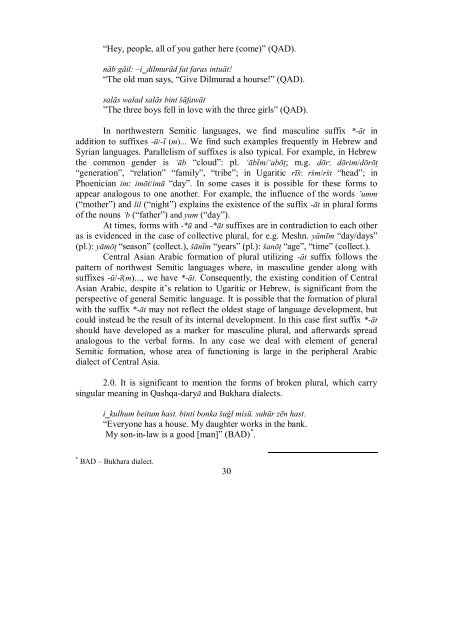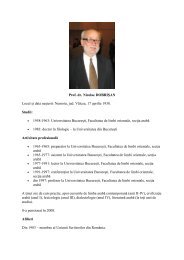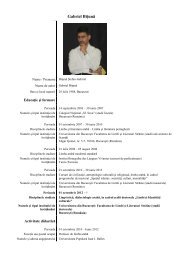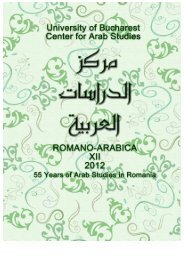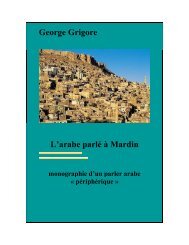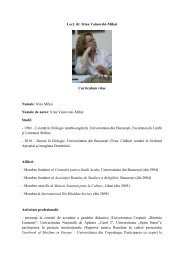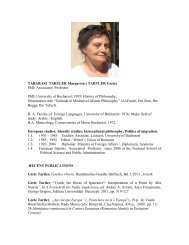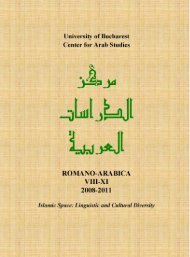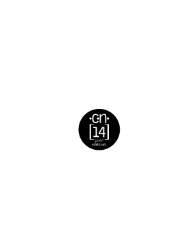University of Bucharest
University of Bucharest
University of Bucharest
Create successful ePaper yourself
Turn your PDF publications into a flip-book with our unique Google optimized e-Paper software.
―Hey, people, all <strong>of</strong> you gather here (come)‖ (QAD).<br />
nāb gāil: –i‗dilmurād fat faras intuāt!<br />
―The old man says, ―Give Dilmurad a hourse!‖ (QAD).<br />
salās walad salās bint šāfawāt<br />
‖The three boys fell in love with the three girls‖ (QAD).<br />
In northwestern Semitic languages, we find masculine suffix *-āt in<br />
addition to suffixes -ū/-ī (m)... We find such examples frequently in Hebrew and<br />
Syrian languages. Parallelism <strong>of</strong> suffixes is also typical. For example, in Hebrew<br />
the common gender is ‗āb ―cloud‖: pl. ‗ābīm/‗abōt; m.g. dōr: dōrim/dōrōt<br />
―generation‖, ―relation‖ ―family‖, ―tribe‖; in Ugaritic rīš: ršm/ršt ―head‖; in<br />
Phoenician im: imōt/imū ―day‖. In some cases it is possible for these forms to<br />
appear analogous to one another. For example, the influence <strong>of</strong> the words ‘umm<br />
(―mother‖) and lil (―night‖) explains the existence <strong>of</strong> the suffix -āt in plural forms<br />
<strong>of</strong> the nouns ‘b (―father‖) and yum (―day‖).<br />
At times, forms with -*ū and -*āt suffixes are in contradiction to each other<br />
as is evidenced in the case <strong>of</strong> collective plural, for e.g. Meshn. yāmīm ―day/days‖<br />
(pl.): yāmōt ―season‖ (collect.), šānīm ―years‖ (pl.): šanōt ―age‖, ―time‖ (collect.).<br />
Central Asian Arabic formation <strong>of</strong> plural utilizing -āt suffix follows the<br />
pattern <strong>of</strong> northwest Semitic languages where, in masculine gender along with<br />
suffixes -ū/-ī(m)..., we have *-āt. Consequently, the existing condition <strong>of</strong> Central<br />
Asian Arabic, despite it‘s relation to Ugaritic or Hebrew, is significant from the<br />
perspective <strong>of</strong> general Semitic language. It is possible that the formation <strong>of</strong> plural<br />
with the suffix *-āt may not reflect the oldest stage <strong>of</strong> language development, but<br />
could instead be the result <strong>of</strong> its internal development. In this case first suffix *-āt<br />
should have developed as a marker for masculine plural, and afterwards spread<br />
analogous to the verbal forms. In any case we deal with element <strong>of</strong> general<br />
Semitic formation, whose area <strong>of</strong> functioning is large in the peripheral Arabic<br />
dialect <strong>of</strong> Central Asia.<br />
2.0. It is significant to mention the forms <strong>of</strong> broken plural, which carry<br />
singular meaning in Qashqa-daryā and Bukhara dialects.<br />
i‗kulhum beitum hast. binti bonka šuġl misū. suhūr zēn hast.<br />
―Everyone has a house. My daughter works in the bank.<br />
My son-in-law is a good [man]‖ (BAD) * .<br />
* BAD – Bukhara dialect.<br />
30


